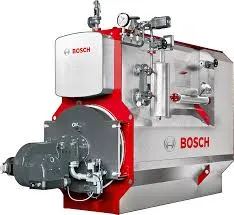
12월 . 15, 2024 05:11 Back to list
Design Principles and Considerations for Efficient Steam Boiler Systems
Steam Boiler Design An Overview
Steam boilers are essential components in various industries where steam-generated heat is a critical utility for processes such as power generation, food production, and chemical manufacturing. The design of a steam boiler is a complex engineering task that involves considerations of materials, thermodynamics, safety, and efficiency. This article provides an overview of the fundamental aspects involved in steam boiler design.
Fundamentals of Steam Boilers
A steam boiler, also known as a steam generator, is a closed vessel that heats water and transforms it into steam through the application of heat energy. The steam produced can then be used for a variety of applications, including heating, powering turbines, and driving mechanical processes. The key parameters that define the performance of a steam boiler are pressure, temperature, and steam quality.
Types of Steam Boilers
There are several types of steam boilers, each designed for specific applications and operational requirements
. The most common types include1. Fire-Tube Boilers In these boilers, hot gases from combustion pass through tubes submerged in water. The heat generated transfers to the water, converting it into steam. Fire-tube boilers are known for their low initial cost and ease of operation but are limited in terms of pressure and efficiency.
2. Water-Tube Boilers These feature water-filled tubes through which hot gases pass. The design allows for higher pressures and temperatures, making them suitable for large-scale applications. Water-tube boilers are typically more efficient and can handle rapid fluctuations in steam demand.
3. Electric Boilers These boilers use electric resistance to generate heat instead of combustion. They are often used in applications where low emissions and high energy efficiency are paramount.
4. Combination Boilers These versatile systems can operate on multiple fuels (e.g., gas, oil, or biomass) and can switch between them depending on availability and cost.
steam boiler design

Design Considerations
Several factors must be considered in the design of a steam boiler
1. Thermal Efficiency The efficiency of a boiler heavily influences operating costs. A well-designed steam boiler maximizes heat transfer and minimizes heat losses. The integration of economizers and superheaters can enhance efficiency by recovering waste heat.
2. Safety Given the high pressures and temperatures involved, safety is a crucial aspect of steam boiler design. Codes and standards, such as those from the American Society of Mechanical Engineers (ASME), provide guidelines for materials, construction, and testing. Safety features, including pressure relief valves, water level controls, and blowdown systems, are imperative to prevent accidents.
3. Materials Selecting appropriate materials is critical for both durability and efficiency. Boilers are commonly constructed from carbon steel or stainless steel, with considerations for corrosion resistance and thermal conductivity. High-performance materials like alloy steels are often used for components exposed to extreme conditions.
4. Control Systems Modern steam boilers are equipped with sophisticated control systems that monitor and regulate parameters such as pressure, temperature, and water level. Advanced systems use sensors and automation to optimize efficiency and safety.
5. Environmental Impact As industries strive to reduce their carbon footprint, boiler design must also address emissions controls. Implementing technologies such as flue gas recirculation, low-NOx burners, and wastewater treatment systems can significantly reduce the environmental impact of steam generation.
Conclusion
The design of steam boilers is a multifaceted discipline that combines engineering principles with practical considerations. By selecting appropriate boiler types, optimizing design parameters, and adhering to safety and environmental standards, engineers can create efficient and safe steam generation systems. As industry needs evolve, ongoing innovations in materials, technology, and design will continue to enhance the performance of steam boilers, ensuring they meet future challenges in energy production and management.
-
Efficient Biomass Fired Hot Water Boiler | AI Heating Solution
NewsAug.01,2025
-
High-Efficiency Gas Thermal Oil Boilers | HPT Models
NewsJul.31,2025
-
Oil Fired Hot Water Boilers Sale - High Efficiency & Affordable
NewsJul.31,2025
-
High-Efficiency Commercial Oil Fired Steam Boiler for Industry
NewsJul.30,2025
-
High-Efficiency Biomass Fired Thermal Oil Boiler Solutions
NewsJul.30,2025
-
High Efficiency Gas Fired Thermal Oil Boiler for Industrial Heating
NewsJul.29,2025
Related PRODUCTS






















